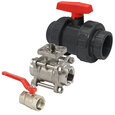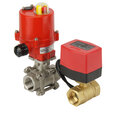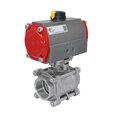Gas Ball Valves: Their Importance and Functionality
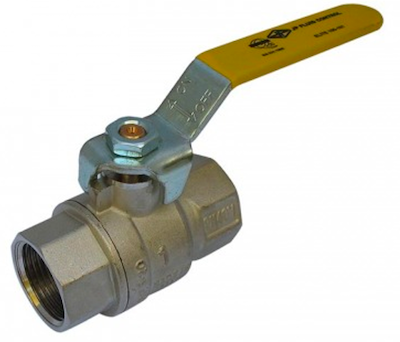
Figure 1: Ball valve rated for gas applications
Gas ball valves are essential components in various gas distribution systems. They control gas flow and ensure safe and reliable residential, commercial, and industrial operations. Gas ball valves have robust construction, high-pressure and temperature tolerance, and adhere to strict industry standards and testing for personnel and equipment safety. This article explores the features, selection criteria, applications, and industrial standards of gas ball valves.
Table of contents
- What is a gas ball valve?
- Features
- Selecting a gas ball valve
- Applications
- Gas ball valve standards
- Gas ball valve testing
- FAQs
View our online selection of ball valves!
What is a gas ball valve?
A gas ball valve is a quarter-turn valve that utilizes a hollow, perforated ball as the closure element. The ball has a hole, or port, through its center, which allows or restricts the flow of gas when the valve is operated. When the ball is aligned with the pipe or tubing, the valve opens, enabling gas to pass through. Conversely, when the ball is rotated perpendicular to the flow path, the valve is closed, obstructing the gas flow.
Gas ball valves are quick and reliable, making them suitable for applications where rapid gas flow control is crucial, such as in emergency shutdown systems or process control operations. Piping systems use gas ball valves to convey fluids like liquid petroleum gas (LPG), natural gasses, hydrocarbons, and chemical oils. These valves effectively control fluid flow within systems for residential and commercial or industrial uses.
Features
Gas ball valves have unique features that make them better suited for the unique demands and requirements of gas applications, ensuring safe and efficient operation.
- Fire-safe design: Gas ball valves often have a fire-safe design to enhance safety in case of fire or extreme temperature exposure. This design includes features such as metal-to-metal seals and fire-resistant materials like graphite to prevent leakage and maintain sealing integrity even during high-temperature applications. Metal-metal seals typically involve contact between metal surfaces, such as the ball and the valve body or the stem and the valve body. The metal-metal contact creates a robust seal that can withstand high pressure and temperature conditions, minimizing the risk of leakage.
- Extended bonnet: The extended bonnet provides additional insulation and protection for the stem and packing, allowing the valve to operate reliably in extreme temperatures.
- Anti-static design: Gas ball valves often incorporate anti-static features to prevent the build-up of static electricity, which can be hazardous in gas applications. Examples are grounding springs or conductive materials, which dissipate any static charge that may accumulate during valve operation.
- Stem and seat sealing: Gas ball valves often have enhanced stem and seat sealing mechanisms to ensure tight shut-off and minimize gas leakage. This includes spring-loaded seats, live-loading of packing, or other sealing technologies to maintain integrity and reduce the risk of gas leakage.
- Yellow handle: Gas ball valves can be distinguished from other valves by their yellow handles (Figure 1), meaning they are CSA-approved and can be used with flammable gasses (discussed later). Although the yellow handle is not official, it can help set gas ball valves apart from others.
- Pilot tap: Gas valves have pilot taps for pressure gauges that control and monitor fluid pressure. These gauges help perform pressure tests to ensure the system operates within the accepted pressure levels.
Selecting a gas ball valve
Consider the Gas Appliance Regulation (GAR) guidelines when selecting a gas ball valve. The gas ball valve should comply with the system requirements like pressure, temperature, and mounting configurations, similar to a typical ball valve. Selecting a gas ball valve also includes considering a few unique criteria, as discussed below:
- Flow characteristics: Consider the gas flow characteristics in the system. Certain gasses may exhibit turbulent flow or have particulates or contaminants present. In such cases, selecting a gas ball valve with a design that minimizes flow disturbances, such as a full port design or unique trim options (specific features or modifications in the valve's internal components that are designed to optimize flow characteristics and minimize turbulence), can help maintain smooth gas flow and reduce the risk of clogging or erosion.
-
Gas ball valve leakage classifications: Gas ball valves are classified based on their leakage rates. The two commonly used classifications are API 598 and ANSI/FCI 70-2.
- API 598 defines six classes of leakage rates, ranging from Class I (zero visible leakage) to Class V (significant leakage allowed).
- ANSI/FCI 70-2 introduces a more precise classification system, ranging from Class I to Class VI, with Class VI representing the tightest shut-off and minimal leakage.
- Materials: Gas ball valves work in high temperature and pressure conditions. It is crucial to prevent the leakage of fluids, given the combustible nature of most of the working fluids. These gas ball valves are either metal or PTFE seated to prevent any possibility of fluid leaks. Aluminum, copper, stainless steel, and brass are popular choices for gas ball valve housing materials.
- Design: Gas ball valves can have either a floating ball design or a trunnion-mounted ball design. Floating ball valves rely on the pressure of the fluid to create a seal between the ball and the seats. Trunnion-mounted ball valves have mechanical anchoring of the ball at the top and bottom, allowing for higher pressure and larger-size applications while maintaining excellent sealing performance.
- Cavity relief mechanism: Gas ball valves often incorporate a cavity relief mechanism to prevent excessive pressure buildup in the valve cavity. This mechanism typically consists of a small relief hole or vent upstream or downstream of the ball. It releases any trapped fluid in the cavity, minimizing the risk of valve damage or malfunction.
- Compliance with industry standards: Gas ball valves are designed and manufactured to meet specific industry standards and regulations, such as those set by organizations like the American Gas Association (AGA), the American Petroleum Institute (API), or the International Organization for Standardization (ISO). These may include standards for explosion-proof or intrinsically safe design standards, fire resistance, or safety certifications.
Read our ball valve selection guide for more details on the parameters to consider while selecting a ball valve.
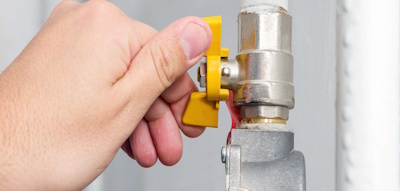
Figure 2: Ball valve rated for gas applications
Applications
Gas ball valves find various applications across various industries where the control, regulation, and isolation of different gasses are required. Here are some typical applications of gas ball valves in specific gas systems:
- Liquefied Petroleum Gas (LPG): Ball valves are commonly used in LPG systems for residential, commercial, and industrial applications. They ensure efficient control and safe shut-off of LPG, enabling reliable usage in distribution networks, storage tanks, cylinders, and equipment like burners, heaters, and stoves.
- Industrial gas systems: Ball valves are essential in industrial gas systems, such as oxygen, nitrogen, and argon. They provide safe and reliable control in gas production plants, storage facilities, and distribution networks, supporting manufacturing processes, welding operations, and laboratory applications.
- Medical gas systems: In medical facilities, gas ball valves are used in medical gas systems for distributing and regulating various gasses.
- Oil and gas industry: Gas ball valves are crucial in wellhead systems, pipelines, refineries, petrochemical plants, and storage facilities, controlling the flow of natural gas, methane, and other hydrocarbons during extraction, processing, and distribution.
Gas ball valve standards
Most countries have a body responsible for ensuring that ball valve designs and ratings are safe.
- American Petroleum Institute (API): API develops standards, including API 6D and API 608, for pipeline and industrial valves used in the oil and gas industry.
- American Society of Mechanical Engineers (ASME): ASME sets standards, such as ASME B16.34, for gas ball valve design, materials, and performance.
- Canadian Standards Association (CSA): CSA develops standards, such as CSA Z245.15, for pipeline valves used in Canada. They also provide certifications and ratings for gas ball valves.
- British Standards Institution (BSI): BSI develops and publishes standards, including BS EN 331, which specifies requirements for gas ball valves used in gas distribution systems in the UK.
- Deutsche Vereinigung des Gas- und Wasserfaches (DVGW):DVGW sets standards for gas and water technologies in Germany. They have specific rules, such as DVGW G 260, for gas ball valves used in gas distribution systems.
- Nederlands Normalisatie-instituut (NEN):NEN is the national standards organization in the Netherlands responsible for developing and promoting standards across various industries.
- International Organization for Standardization (ISO): ISO is an international standard-setting body that develops standards for various industries, including gas ball valves. For example, ISO 17292 specifies the requirements for metal ball valves used in natural gas, and allied industries.
The specific pressure ratings and designations may vary based on regional standards, regulations, and specific manufacturer specifications.
Gas ball valve testing
Gas ball valve testing involves various procedures to assess their performance, integrity, and compliance with industry standards.
- Pressure testing: The valve is subjected to elevated pressures (approximately 1.5 times the rated pressure) to simulate real-world operating conditions and verify its ability to withstand the specified pressure rating without leakage or failure. Pressure tests typically involve gradually increasing the pressure and monitoring for any signs of leakage or structural integrity issues.
- Leakage testing: Leakage testing is crucial to ensure the gas ball valve maintains a tight seal and does not allow any gas leakage, which could pose safety hazards.
- Flow testing: Flow testing assesses the performance of the gas ball valve in terms of its ability to regulate the gas flow accurately and consistently. This test measures parameters such as flow rate, pressure drop, and the valve's response to changes in flow conditions.
- Endurance testing: Endurance testing evaluates the long-term durability and operational reliability of the gas ball valve. It involves subjecting the valve to repetitive cycles of opening and closing, simulating its expected lifespan under normal operating conditions. This testing ensures that the valve can endure frequent usage without deterioration in performance or structural integrity.
FAQs
Can you use a ball valve for gas?
Yes, ball valves are commonly used for gas applications because they provide efficient control, reliable shut-off, and ease of operation in gas systems.
What valve to use for natural gas?
A gas ball valve is an excellent valve choice for natural gas. They are reliable, durable, and offer a good seal.
Can a gas ball valve be used for water?
While gas ball valves are primarily designed for use with gasses, they can also be used for water applications in some instances. However, consider the valve's material compatibility, pressure and temperature ratings, and any applicable certifications or standards for water applications.
What are the differences between water and gas ball valves?
Water ball valves may use materials more compatible with water and have lower pressure ratings. Gas ball valves may require specific certifications or approvals for gas applications, which may not be necessary for water ball valves.




